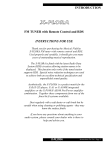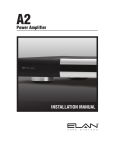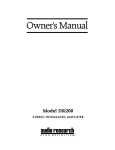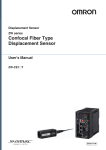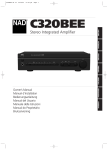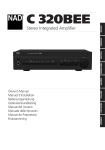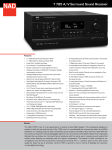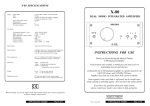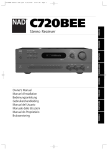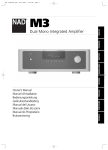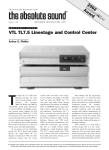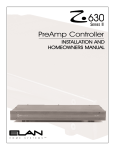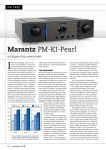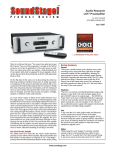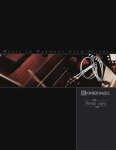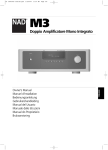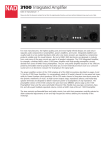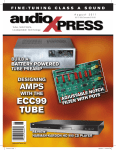Download VTL S-400 Reference
Transcript
E Q U I P M E N T R E P O R T Electronically reprinted from December 2005 VTL S-400 Reference Brian Damkroger DESCRIPTION Tubed stereo power amplifier. Inputs: 1 pair unbalanced (RCA), 1 pair balanced (XLR). Outputs: 2 pairs binding posts. Tube complement: two 12AT7, two 6350, twelve 6550C (KT88). Rated power output at <3% distortion: 300W into 8 ohms (24.8dBW), 400Wpc into 4 ohms, tetrode (23dBW); 150Wpc into 8 ohms (21.8dBW), 200W into 4 ohms (20dBW), triode. Frequency response: 10Hz–125kHz, +0/–3dB. Output impedance: ca 1–1.5 ohms. Input impedance: 57k ohms. Input sensitivity: 2.2V for full output. Power consumption: 480W at idle, 2500W at full power. DIMENSIONS 24" (615mm) H by 11.5" (295mm) W by 24" (615mm) D. Weight: 220 lbs (100kg) net, 330 lbs (150kg) shipping. SERIAL NUMBER OF UNIT REVIEWED 04376106 (auditioning); 05146432 (measuring). Approximate number of dealers: 47. Warranty: 5 years, nontransferable. MANUFACTURER VTL Amplifiers Inc., 4774 Murrieta Street, Suite 10, Chino, CA 91710. Tel: (909) 6275944. Fax: (909) 627-6988. Web: www.vtl.com. Email: [email protected] www.Stereophile.com, December 2005 POWER AMPLIFIER VTL S-400 Reference power amplifier W hen I reviewed VTL’s MB-750 monoblock amplifier in the December 1997 Stereophile (Vol.20 No.12), it was a transitional time for the company. Luke Manley had recently taken it over, and he and his wife and partner, Bea Lam, were aggressively retooling. They introduced new business systems, including rigorous inventory and quality control; rebuilt VTL’s dealer network around toprank dealers; and systematically upgraded the products themselves to improve their consistency, reliability, manufacturability, and performance. VTL’s goal, Luke explained to me at the time, was to build amplifiers that competed with the very best, and to “make the tubes invisible to the customer.” The plan rolled out just as Manley had envisioned, and VTL amplifiers evolved through several iterations: the MB-750 saw both Signature and Reference editions, and the flagship MB-1250 Wotan set a new standard in tube amplifier performance. However, having to bias the tubes manually—in the case of the Wotans, 24 per amp—didn’t exactly make them user-friendly. So in the background, a multidisciplinary team of VTL engineers was already working on a completely new generation of products. The first to appear was the sensational TL-7.5 line preamplifier, which Paul Bolin raved about in the October 2003 issue. The next to break VTL S-400 cover were two power amplifiers, the 800W Siegfried monoblock and the subject of this review, the two-channel S-400 Reference. Talkin’ ’bout a g-g-generation we’ve not seen before It’s hard to know where to start in describing the $20,000 S-400, so different is it from what’s come before. You could start by listing everything you might want a tube amp to do, and that’s just what VTL did. Then they turned their engineering team loose on the project. A few things are obvious: balanced and single-ended inputs, a rear-panel 0°/180° phase switch, fully differential input, low idle current standby, and mute, and a soft-start mode to extend tube life. And, like most VTL amps, the S-400 can be run in tetrode (300Wpc/8 ohms) or triode (150Wpc/8 ohms) modes. It also has extensive protection circuitry, with a fuse for nearly everything—and even a rear-panel socket and switch for testing the fuses. The S-400’s sleek, tower-style shape echoes the TL-7.5’s, and its component quality, fit, and finish are superb. The list goes on. The S-400 biases itself for you, checking and setting each tube’s bias during the power-up cycle, then tweaking it whenever the amp senses that no signal is present. It also constantly monitors the tubes and, if a fault is detected, indicates which tube is ailing and whether or not the amp is in danger. If it is, the S-400 shuts down; if it isn’t, the problem tube is effectively removed from the circuit, and the amp rebalances and continues without it. The S-400 also checks for overheating, indicates if there’s a problem, senses and displays several types of powersupply faults, and shuts down the amp, or not, accordingly. Pretty impressive, but we’re just getting started. Removing a small panel reveals a cluster of six buttons and LEDs that provide still more information and access to additional diagnostic and programming functions. From here, a user can turn various displays and indicators on or off, and display total tube or amplifier hours, input voltage or voltage set point, and rear heatsink temperature. These buttons also allow the fault indicators to be cleared. The user can also display the bias level for each tube, then use these data to juggle tubes to create the most closely matched pairs. Because bias THE S-400 BIASES ITSELF FOR YOU, CHECKING AND SETTING EACH TUBE’S BIAS DURING THE POWER-UP CYCLE. level is an early indicator of tube degradation, plotting bias levels against time can help determine when it’s time to retube. When you do retube, be sure to reset the tube time to zero and clear the preset bias settings. You want the S-400 to gently raise the bias level to find the new tubes’ optimal points, rather than risk damaging them by starting at the old tubes’ bias levels. If by now your eyes are glazing over and you’re starting to think that this would be a lot easier if you could just hook up a laptop, VTL’s engineers have beaten you to it. An RS-232 connector on the rear panel allows you to read, log, and control all of this from your computer. All of the displays, codes, functions, and software commands are explained wonderfully in VTL’s comprehensive user’s manual. New cosmetics, more buttons and features—same old circuit? Not even close. Making the tubes “disappear” was one of VTL’s goals for the S-400; the other was to set a new standard in sonic performance. When I called Luke Manley to walk through the circuit’s details, the conversation quickly moved from what to the much more interesting questions of why and how. “The business has changed,” he explained. “There’s a new generation of amplifiers that sound fast and very neutral, and although we could achieve that to an extent [with older designs such as the Wotan], it was very intimidating, and our target customer doesn’t want to fiddle with their equipment. “Our first choice was to use tubes. They’re inherently linear voltage amplifiers and require a very small amount of feedback. Then, to get the neutrality we wanted, the tubes had to be kept at their optimum operating point—hence the autobias. However, to keep the signal path simple, the autobias circuitry had to be completely removed from the audio circuitry during operation, so we needed to come up with a way to do that. “All these things, and the need to manage current inrush during startup, required the use of microprocessors. And then we were quickly in a position that required totally new design expertise, but also enabled us to do a lot of things that we couldn’t have otherwise. We were able to manage everything that we needed to to ensure optimum operation and maximum tube life. Then we added all of the diagnostics and indicators to monitor conditions and satisfy the customer’s curiosity.” I asked Luke what made the S-400 sound the way it did—what’s the magic? “There are really three things that contribute. The first is the collection of everything we learned and developed during the evolution of our other amps. There are the wide-bandwidth output transformers, with single-tap outputs. We had a good starting point for parts selection from before, based on matching and extensive listening, and knew how to optimize feedback. The second piece was developing a true balanced differential input, with 60dB of common-mode noise rejection. “But the biggest thing is the precision regulated power supply. Along with maintaining correct bias, the way to keep tubes at their optimum operating point is by regulating the hightension power supply. Normally, the voltage begins to sag as power is pulled out of the supply, and B+ voltage might drop by as much as 10%. The S400’s supply never varies by more than 0.1% or 0.2%. “The S-400’s supply is essentially a power amp in itself. The regulation requires six 3,300μF capacitors and five 800V, 30A MOSFETs. They’ve got tremendous transconductance, so when the caps dump, the regulation keeps the voltage propped up. The screen grids are particularly sensitive, so they’re actually double-regulated. Their supply is taken off of the regulated plate supply, stepped down, and further regulated at the lower level.” When I asked him to contrast this with the supplies in older VTL amps, such as my own Ichibans, Luke said, “With the older amps, the power supply floated with AC voltage—in addition to sagging. There was no way to keep the tubes at their optimum point. We always knew that precisely regulating the supply was better, but we didn’t have the technology to manage the regulation.” VTL S-400 I’VE HEARD A LOT OF AMPS, INCLUDING A FEW REALLY SUPERB ONES, BUT NONE THAT SOUNDED AS TONALLY NEUTRAL AS THE S-400 IN TETRODE MODE. Beneath the S-400’s top cover. The green LED lights beside each tube confirm status and blink to indicate a bias adjustment is underway. Engineers love gadgets, but the proof is in the pudding I spent the better part of a year with the S-400, during which time it shared power-amp duties with the Simaudio Moon Rocks, Mark Levinson No.20.6s, and my much-updated VTL Ichibans. I mated the S-400 with several different preamps and CD players and a wide range of cables. Two constants throughout were my Thiel CS6 loudspeakers and my analog front end: a VPI HR-X turntable and tonearm and a Lyra Titan cartridge. First, I can attest that VTL has succeeded in their goal of “making the tubes invisible.” After the novelty wore off of watching the blinking biasing LEDs and accessing the diagnostic displays, I never gave the S-400 and its wizardry a second thought. I’d push the Power button, watch “240” appear on the front-panel display and start counting down the seconds, and go pick out a record. Based on my year or so with the amp, I’d pronounce it both plug’n’play and absolutely bulletproof. In fact, the only thing that reminded me the VTL was in the system was its no-extra-charge space-heater function, a result of its dissipating 480W at idle and a whopping 1700W at full power. To put this in perspective, the Sears Deluxe Digital Vortex Heater I was looking at last winter has settings of 800W and 1500W, and “efficiently heats a 16' x 16' room.” When Trish and Luke Manley were discussing my then-new listening room over Christmas break, Luke asked if I’d installed any sort of heater. “Just your amp, Luke,” she responded, “but that seems to be enough.” I’m teasing, but it’s true—the heat it threw off was the only thing that consistently reminded me of the S-400’s presence. I tried in vain to isolate its sonic thumbprint by installing it in familiar setups. Each time I replaced another amp with the VTL, a distinct coloration was removed from the system’s sound, but I could never definitively identify what, if anything, the S-400 had added. What was the VTL’s character? In some cases of recordings or partnering gear I noted a faint coolness suggesting a slight frequency-response dip or reduced dynamics in the upper bass, and perhaps the opposite in the upper midrange—but that’s an awful lot like the character of my Thiel CS6 speakers. At other times I detected a politeness, less-than-explosive dynamics, and a very minor softening of transients—which reminded me a lot of how Michael Fremer described his impressions of the latest Lyra Titan cartridge in one of our e-mail exchanges. I’d never heard these subtleties before, but does that link them with the S-400, or merely suggest that removing the other amps’ colorations allowed the speakers’ and cartridge’s to be heard? I suspect the latter, but if that’s true, what was associated with the VTL? Neutrality? Clarity? Transparency? In the case of neutrality, the answer is yes, absolutely. I’ve heard a lot of amps, including a few really superb ones, but none that sounded as tonally neutral as the S-400 in tetrode mode. There was a simple, almost stark honesty to its portrayal of instruments’ tonal structures that, in comparison, laid bare the artifacts that the other amps contributed to instruments and voices. In fact, merely switching the S-400 between its tetrode and triode modes provided a wonderful example of this. Switching to the S-400’s triode mode—or to the Simaudio Moon Rocks that I reviewed in September, for that matter—added a touch of warmth and sweetness to the sound and seemed to gently roll off the highest frequencies. Ramsey Lewis’ piano on his trio’s 1965 live recording, Hang On Ramsey (LP, Cadet LP-761), was a good example. It sounded pretty good with the VTL in triode, but transients were slightly dulled, giving me a sense that the top end wasn’t as open and extended as it could be. Plus, the piano’s notes sounded homogenized and slightly thick, with no obvious inner structure or temporal evolution. And although I was never aware of a distinct change in amplitude as Lewis played down into the instrument’s lower ranges, there was a richness to the notes that seemed to increase as the pitch dropped. In tetrode mode, on the other hand, Lewis’ piano was dead-on. Each treble note was clearly a changing mix of harmonics, that went through a distinct evolution: from a sharp, cutting transient through a quick bloom and decay. Similarly, Red Holt’s cymbals were slightly muted, with a thick, metallic hiss in triode mode but a startlingly clear mix of components in tetrode mode. The differences were even more obvious moving down through the midrange and bass. Going back to Lewis’ piano, running the S-400 in tetrode mode resulted in an even more complex evolution of the sound after the initial transient, an obvious progression of string vibrations building in complexity and increasingly exciting the instrument’s soundboard. Ray Brown’s bass on the Pure Audiophile reissue of Soular Energy (LP, PA 002) was another great example: warm and full to the brink of being overstated through the Moon Rocks or my Ichibans, still highlighted but more clearly detailed and realistically balanced through the S-400. I was initially suspicious of the S400’s apparent neutrality. Given its relatively high output impedance (1–1.5 ohms), I expected to hear at least some frequency-response anomalies due to the amp’s interaction with the speaker load. Plus, John Atkinson’s measurements always show this sort of behavior in VTL and other, similar amplifiers. I dug into this a bit, however, and discovered one possible explanation. Between 50Hz and 10kHz, JA’s simulated speaker load fluctuates between 4 VTL S-400 ohms and >20 ohms, with huge peaks around 70Hz and 1kHz (www.stereo phile.com/reference/60/index1.html). In contrast, his measurements of the Thiel CS6 showed a much flatter impedance curve that varied by only about 1 ohm over the same range, and within an even narrower band for much of that span (see the March 1998 Stereophile, Vol.21 No.3, p.96). Another component of the S-400’s presentation and its lack of a sonic thumbprint was its clarity. In addition to the changes I describe above, I noted that switching the VTL to triode mode, or swapping in the Sims, Ichibans, or Levinsons, wove a liquid texture into the sound, and fine details—spatial, temporal, and tonal—weren’t quite as clear. Going back to the S-400 or switching from triode mode to tetrode was akin to opening a window that is not quite optically perfect. With the S-400 in tetrode mode, fine details were much easier to identify and follow, but a more significant effect was the realistic presence and immediacy that imbued every component of the performance. On Hang On Ramsey, it was there as much in the applause and bassist Eldee Young’s singing along with his own solos as it was in Lewis’ piano. I went through box after box of my favorite opera sets, just to hear them come alive with the S400’s clarity. I’m sure that there was fine detail in spades, the soundstage was appropriately large, and the image dimensionality and ambience cues were beautifully rendered, but I really didn’t notice any of that. I was too busy sitting in the audience of a virtual opera house, alternating between quickly reading the libretto and closing my eyes to melt into the performance. Perhaps my favorite example of the S-400’s stunning clarity was Jimmy Smith’s Hammond B-3 organ on his Who’s Afraid of Virginia Woolf (LP, Verve SMAS 90577), a wonderful Rudy Van Gelder production from 1964. The organ’s slightly buzzy, electronic texture was perfectly reproduced by the S-400. Combined with Smith’s mesmerizing, expressive playing, the VTL’s clarity seemed to erase the recording/playback chain altogether, plopping Smith, his organ, and the backing players right in front of me. Most spectacularly, voices lit up and came alive with the S-400. I constantly found myself digging out older, more simply recorded live recordings, such as Johnny Rivers’ Whisky-A-Go-Go LPs. “Brown-Eyed Handsome Man,” from Johnny Rivers at the Whisky-A-Go-Go (Imperial LP12264), is one of my favorite cuts; with any good system, it will transport me to a front-center seat at the club. But the first time I heard it through the S-400, I was stunned. I actually caught myself looking around to see which of my fellow audience members was talking and singing along. Incredible. The third of the VTL’s attributes, its transparency, is the easiest to describe in audiophile terms. I could simply hear much farther into the soundstage with the S-400 than with the Sims, Ichibans, or Levinsons. And with the S-400, the limit wasn’t the system running out of resolution at the rear of the stage, or losing ambient detail into a background texture. Instead, I could either hear whatever surface bounded the recording space, or hear the microphones’ sensitivities reach their limits. And up to either of these points, I heard nothing other than the recording venue. This transparency favored live recordings—especially more simply recorded performances—where the miking patterns had been integrated into a seamless envelope. The Johnny Rivers and Ramsey Lewis albums sounded coherent, immediate, and alive—and these are standard, buy-atthe-corner-store LPs. Simple, welldone recordings given a modern audiophile makeover, such as AcousTech’s reissue of Lightnin’ Hopkins’ Goin’ Away (LP, P re s t i g e / B l u e s v i l l e /Ac o u s Te c h 1073), were amazing, and closer to fulfilling the promise of recorded and reproduced performances than I’d ever heard before. How do you put the puzzle together when you can’t find the pieces? After about a year of listening to the VTL S-400 in different configurations and comparing it with some very good amplifiers, I’m still at a loss to assign to it any specific, overt sound. It might sound a little polite, and it might lack a little weight in the upper bass and lower midrange—but then again, it might not. Its colorations were so minor that I have no frame of reference within which to isolate and identify them. All I can do is describe what the S-400 did not add to the sound, which is really just a description of what other amps I compared it with and the other components in my system. As superb as those other amplifiers and components are, the VTL’s neutrality, clarity, and transparency set it apart. The VTL S-400 may be expensive, but it is the product of an intense, fiveyear development effort and the marriage of several engineering disciplines. Whether you measure it against VTL’s ambitious design goals or against its peers, the S-400 is a stunning achievement—a technological tour de force and a home run in terms of both usability and sonic performance. Congratulations to Luke Manley, Bea Lam, and the VTL design team. Twenty years from now, we’ll all remember the S-400 as a benchmark in tube amplifier design, and the first of a new generation. Today, my recommendation is that you find one, see and hear what it can do, and get out your checkbook.` ■■ ASSOCIATED EQUIPMENT DIGITAL SOURCES Burmester 001, Cary 300/303 CD players. ANALOG SOURCE VPI TNT HR-X turntable & tonearm, Lyra Titan cartridge; Sutherland PhD, Ensemble Fonobrio phono stages. PREAMPLIFICATION VTL TL-7.5, Sutherland Director, Placette active line stages; Placette Remote Volume Control, Sonic Euphoria PLC passive line stages. POWER AMPLIFIERS VTL Ichiban, Simaudio Moon Rock, Mark Levinson No.20.6 (all monoblocks). LOUDSPEAKERS Thiel CS6. CABLES Interconnects and speaker: Nirvana S-X Ltd., Audience Au24, Nordost Valhalla, Silversmith Silver. AC: Audience PowerChord, Synergistic Research Designers’ Reference. ACCESSORIES MIT Z-Center, Audience AdeptResponse AC conditioning & distribution systems; FIM 880 AC outlets; Finite Elemente Reference equipment stand & Ceraball footers, Nordost footers; Audio Tools equipment & CD storage racks; VPI 16.5 record-cleaning machine, VPI & Disk Dr. record-cleaning fluids, Immedia SPT stylus-cleaning fluid, Zerostat antistatic gun, Nordost ECO3 & Audience Aural Illuminator CD cleaners/treatments. —Brian Damkroger Posted with permission from the December 2005 issue of Stereophile ® www.stereophile.com. Copyright 2005, PRIMEDIA Inc. All rights reserved. For more information about reprints from Stereophile, contact Wright’s Reprints at 877-652-5295 M E A S U R E M E N TS F or logistical reasons, I measured a different sample of the S-400 to the one BD auditioned. My sample had been used at the Home Entertainment Show last May and came to me following the Show, before its return to New York dealer Sound By Singer. With its choices of unbalanced and balanced inputs, and triode or tetrode output-stage operation, VTL’s S-400 is four amplifiers in one. To make measuring its performance feasible, I carried out complete sets of tests for both triode and tetrode operation in balanced mode, spot-checking some measurements via the unbalanced input. All the inputs preserved absolute polarity, the XLRs appearing to be wired with pin 2 hot. Before I did many tests, the amplifier was run for an hour at one-third power in tetrode mode into 8 ohms . The voltage gain into 8 ohms was the same with both balanced and unbalanced drive, but differed between the two output modes: tetrode was 27.2dB, triode lower at 25.3dB. The unbalanced input impedance was a moderately high 74.2k ohms at 1kHz, dropping at the frequen- Fig.3 VTL S-400, tetrode mode, small-signal 1kHz squarewave into 8 ohms. cy extremes to 56k ohms (20Hz) and 44.4k ohms (20kHz). As expected, the balanced input impedances were twice these figures. The S-400 should not load down the output of any preamplifier with which it is used. The output impedance also differed between the two operating modes, ranging from 1.82 ohms at 1kHz to 1.9 ohms at 20Hz and 20kHz in tetrode mode, and from 1.66 ohms at 1kHz to 1.7 ohms at the frequency extremes in triode mode. As a result of the Ohm’s Law interaction between this source impedance and the manner in which a loudspeaker’s impedance changes with frequency, Fig.1 VTL S-400, tetrode mode, balanced frequency response at 2.83V into (from top to bottom at 2kHz): simulated loudspeaker load, 8, 4, 2 ohms (1dB/vertical div., right channel dashed). Fig.4 VTL S-400, triode mode, small-signal 1kHz squarewave into 8 ohms. Fig.2 VTL S-400, triode mode, balanced frequency response at 2.83V into (from top to bottom at 2kHz): simulated loudspeaker load, 8, 4, 2 ohms (1dB/vertical div., right channel dashed). Fig.5 VTL S-400, tetrode mode, distortion (%) vs 1kHz continuous output power into (from bottom to top at 1W): 8, 4, 2 ohms. there was a significant, ±0.6dB modification of the amplifier’s frequency response by the magazine’s simulated speaker in both modes (fig.1, tetrode; fig.2, triode). Note the more extended ultrasonic bandwidth of tetrode compared with triode in these graphs: –3dB at 115kHz vs –3dB at 87kHz, respectively. (The unbalanced responses were identical.) Both bandwidths are more than is necessary to handle audio signals, but correlate with Fig.8 VTL S-400, triode mode, THD+N (%) vs frequency at 2.83V into (from bottom to top): 8, 4, 2 ohms. Fig.6 VTL S-400, triode mode, distortion (%) vs 1kHz continuous output power into (from bottom to top at 1W): 8, 4, 2 ohms. Fig.7 VTL S-400, tetrode mode, THD+N (%) vs frequency at 2.83V into (from bottom to top): 8, 4, 2 ohms. superb reproduction of a 10kHz squarewave (fig.3, tetrode; fig.4, triode). However, tetrode mode reveals some damped overshoot on the squarewave’s leading edges, this increasing in level into higher impedances. Channel separation (not shown) was better than 90dB in the midrange, decreasing slightly at the top of the audioband. Background noise levels were low, with the A-weighted signal/noise ratio (ref. 1W into 8 ohms) measuring 91.4dB in tetrode mode, 89.3dB in triode. The wideband, unweighted figures were still good, at 78.4dB and 80.2dB, respectively. Figs.5 and 6 plot the THD+noise percentage present in the S-400’s output against output power into 8, 4, and 2 ohm loads, for tetrode and triode operation, respectively. As is usual with an amplifier featuring low loop negative feedback, the distortion rises linearly with increasing power. We usually assess an amplifier’s maximum power when the distortion in its output reaches 1%, but as shown by figs.5 and 6, the S-400’s power delivery is limited when this criterion is applied. VTL specifies the amplifier’s power at a more relaxed 3% THD+N, and at this level the S-400 gave out Fig.9 VTL S-400, tetrode mode, 1kHz waveform at 1.5W into 4 ohms (top), 0.098% THD+N; distortion and noise waveform with fundamental notched out (bottom, not to scale). Fig.10 VTL S-400, triode mode, 1kHz waveform at 1.05W into 4 ohms (top), 0.107% THD+N; distortion and noise waveform with fundamental notched out (bottom, not to scale). 325W (25.1dBW) into 8 ohms in tetrode mode, 200W (23dBW) in triode mode. Into 4 ohms, the maximum powers available were 405W (23.1dBW) and 220W (20.4dBW), respectively. The amplifier works very hard into 2 ohms, however, with 220W available in tetrode mode (17.4dBW) and 200W in triode mode (17dBW). (VTL specifies the S-400’s optimal load as 5 ohms.) This is also revealed by the plots of the S400’s small-signal THD+noise against frequency (fig.7, tetrode; fig.8, triode), where the 2 ohm performance is less good than that into higher impedances. However, the VTL’s small-signal distortion is heavily second- and third-harmonic in nature (fig.9, tetrode; fig.10, triode), which will be subjectively innocuous, especially at the low static levels featured in these graphs. At high powers, the S-400’s low loop feedback means that higher-order harmonics make an appearance (fig.11, tetrode; fig.12, triode), though the fact that the harmonics decrease linearly in level with increasing order works against their audibility, especially in triode mode. (Note the commendable absence of power-supply–related spuriae in these graphs.) The big VTL did less well when it came to high-power intermodulation testing (fig.13, tetrode; fig.14, triode; both taken just below visible waveform clipping on the oscilloscope screen), which is what I expected from the decreasing linearity shown at high frequencies in the THD plots (figs.7 and 8). VTL’s S-400 is a thoroughly worked-out tube design whose computer-monitored operating conditions should ensure many years of service. Its designer’s decision to go for low levels of loop negative feedback does compromise the amplifier’s highpower linearity, but the tradeoff is probably the very low levels of static distortion when the amplifier is giving out less than 10W. Even so, it is probably best to avoid speakers that plunge much below 4 ohms to get the maximum dynamic range from this amplifier, even though I note that BD had no problems driving his Thiel CS6es, which remain between 2.5 ohms and 4 ohms over most of the audioband (see www.stereophile.com/floorloudspeakers/218/index4.html). —John Atkinson Fig.11 VTL S-400, tetrode mode, spectrum of 50Hz sinewave, DC–1kHz, at 85W into 8 ohms (linear frequency scale). Fig.13 VTL S-400, tetrode mode, HF intermodulation spectrum, DC–24kHz, 19+20kHz at 140W peak into 8 ohms (linear frequency scale). Fig.12 VTL S-400, triode mode, spectrum of 50Hz sinewave, DC–1kHz, at 50W into 8 ohms (linear frequency scale). Fig.14 VTL S-400, triode mode, HF intermodulation spectrum, DC–24kHz, 19+20kHz at 90W peak into 8 ohms (linear frequency scale). F O L L O W - U P : V T L T L - 7. 5 L I N E P R E A M P L I F I E R V TL’s TL-7.5 Reference line preamplifier was designed by the same team, and around the same philosophy, as the S-400 Reference power amplifier, and from the beginning the two models were intended to be used together. Typically, when a design team creates matching products, much attention is paid to ensuring that their characteristics at least complement each other and, if possible, achieve a positive synergy. The Burmester 011 preamplifier (which I reviewed in the July 2005 issue) and 001 CD player are great examples of this: excellent alone, magical when used together. But given that I had a hard time pinning any sort of sonic signature on the S-400, I couldn’t help but wonder what that suggested about its companion preamp, the TL-7.5 Reference line stage—so I asked to borrow one and hear for myself. Because I had several CD players capable of driving the S-400 directly, I tried to isolate the 7.5’s sound by switching it in and out of the signal chain, and by comparing it with the Burmester 001 and the Placette Remote Volume control. As with the S-400, I found it nearly impossible to ascribe any specific sound to the TL7.5. Inserting it between an amplifier and a CD player—any CD player, even the Burmester 001—enlarged the scale of dynamic transients somewhat, and made microdynamics and inner detail much clearer, though not unnaturally so. My conclusion, after extended listening trials, was that the VTL was removing a slight dulling and veiling of the sound rather than artificially goosing it up. The same was true for other subtle aspects of the sound. With the TL-7.5 in the system, the soundstage was larger and airier, and both clarity and transparency were improved. Comparing the VTL to the little Placette reduced the differences quite a bit, but they were still there, particularly the improvement in dynamics and image dimensionality and, to a lesser extent, inner detail. The Placette’s transparency really impressed me when I first heard it; since then it’s been a standard against which I’ve compared preamps and CD analog stages. Until the TL-7.5, nothing had come close, but the VTL really seemed to combine the best of both worlds: the Placette’s neutrality and transparency with the ability to accurately reproduce dynamic transients from the smallest to the largest, and from the bottom to the top of the frequency spectrum. Recalling that Paul Bolin had raved about VTL’s TL-7.5 when he reviewed it in the October 2003 Stereophile, I pulled his piece up from www.stereophile.com/tubepreamps/938, to see what, specifically, he’d had to say about it. I nearly fell out of my chair. Not only did his impressions and conclusions about the TL-7.5 mirror mine, they sounded eerily like what I’d heard from and written about the S-400 amplifier. “It is no easy thing to attempt to describe the ‘sound’ of a component that had less intrinsic sonic character than anything else I have ever reviewed. The TL-7.5 had such an infinitesimal sound of its own, and did everything so supremely well, that I found nothing to rationally criticize. Sonically, it simply did not exist in the signal chain.” Well done, Paul. I couldn’t have said it better. Having spent a year with VTL’s S-400 and TL-7.5, my conclusion is that they are indeed a matched pair, but not because each synergistically complements the other’s signature. Instead, VTL has effectively removed the colorations from both and lets the music—and the rest of the system, of course—speak for itself. Just as the S-400’s $20,000 price is a lot to spend on a power amp, the TL-7.5’s $13,500 tag is a lot to spend on a line stage—but I’ve heard nothing else like it. These are true benchmark products. —Brian Damkroger Posted with permission from the December 2005 issue of Stereophile ® www.stereophile.com. Copyright 2005, PRIMEDIA Inc. All rights reserved. For more information about reprints from Stereophile, contact Wright’s Reprints at 877-652-5295








